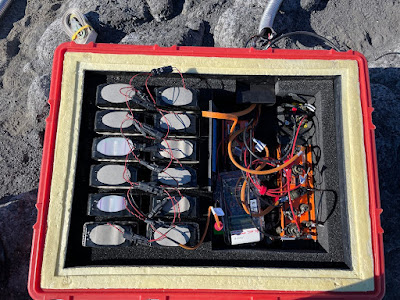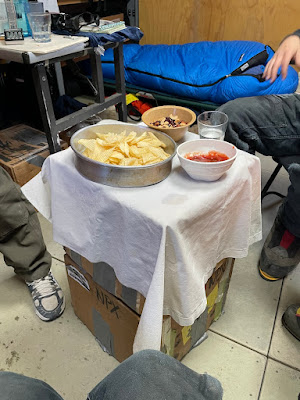The PASSCAL crew installed a seismic and infrasound station at Cape Royds as part of the Erebus Perimeter network!
On Tuesday 22 Nov, Alan, Avi, and I loaded ourselves and all our equipment into a Bell 412 helicopter. We were going to install a full seismic/infrasound station from the ground up, which requires a lot of equipment (sensors, datalogger, batteries, enclosures, cables) and tools (guy wiring, rock bolts, drills, a generator).
 |
| Sitting in the back of the helo with boxes and boxes of equipment. |
 |
| Helicopter helmet and seatbelt secured! |
We took a short 20 minute flight over to Cape Royds, landing next to a small camp that houses 2 scientists studying the penguin colony nearby. The helicopter pilot and helitech helped us unload all of our equipment and quickly took off again.
 |
| Looking back at the Cape Royds camp, which consists of one heated, permanent tent, and one smaller tent for sleeping. The Trans-Antarctic mountains are visible over open ocean on the right. |
Then, the PASSCAL crew had about 30 minutes to find a good spot to install our seismic station before another helicopter with the rest of our equipment arrived. We hiked a short distance away from the camp until we found a nice flat spot with large rocks that we could drill into. Avi and I drew a huge "X" on the ground where we wanted the remaining equipment to be dropped, and we all crouched behind some nearby rocks to wait.
Another helicoper soon appeared with a slingload, a huge net filled with our equipment dangling from underneath. The pilot expertly navigated over our "X" and dropped the slingload in the dead center.
 |
| A-Star helicopter dropping off a slingload at our chosen site. |
Once the helicopter left, we got to work, unloading the sling and moving the heavy enclosures around to roughly lay out the site footprint.
 |
| An orange dome (left) and blue barrel (right) that will be used to install our seismic sensor, with a beautifully clear view of Mt. Erebus in the background. |
Avi and Alan worked on installing the seismic sensor. The type of sensor we were installing required a vault; they needed to bolt a blue barrel to the rock, and then carefully place the sensor inside.
 |
| Using a large drill to bolt the barrel into the rock. |
While they worked on that, I plugged all of the electronics together (just not powering them on yet!). This also included the very fun time of unwrapping each lithium battery from 2 layers of plastic wrap and 1 layer of cardboard. After an incident last season when another science group did not package their batteries properly and one started smoking during a flight, helicopter operations has cracked down on packing batteries correctly.
 |
| Electronics nearly fully installed in the enclosure. 12 Lithium batteries on the left, and datalogger, hard drive, and modem on the right. |
I also worked on running cables through conduit. We do this at our snow installs to prevent cables from being sliced by a shovel when digging them out, and at rock installs (like this one) to prevent them from being blown around and beat up by the wind. After cutting the conduit to size and running the cables through, we stack large rocks on top to hold the conduit in place.
 |
| Cutting the conduit with a hacksaw is hard work.... but what a view!!!!! |
 |
| Running a cable through conduit with Alan. Avi is starting to install solar panels in the background. |
While Avi and Alan worked on solar panels and rock bolts, I installed the infrasound sensor. During the last year, I designed and built out fiberglass boxes to house the infrasound sensors in and protect them from the elements. The housing then goes under a windscreen that helps reduce wind noise in the infrasound data. Normally, we would bolt the wind screen to the underlying rock, but based on the site we selected, there were no great places to bolt into. So we just stacked heavy rocks around the windscreen to keep it from blowing away.
 |
| Infrasound sensor inside fiberglass housing. |
 |
| Stacked rocks on top of housing. |
 |
| Windscreen on top of housing, surrounded by more rocks. The infrasound sensor is installed ~30ft from the electronics box to keep noise from the electronics low in the data. |
We used a solar panel mounts called lampshades at this site. These are a PASSCAL design, consisting of three 20W solar panels arranged in a triangle on top of an aluminum pole. There are different methods of installation depending on the type of environment the panels are used in.
In a snow install, we attach the base of the pole to a large square of plywood and bury it in the snow. At a high-wind rock install like this one, we rock bolt the base into the ground and then attach 3 guy wires to keep the panels more secure.
 |
| Alan and Avi installing rock bolts around the base of the lampshades. |
 |
| Attaching the guy wire to the top of the pole. |
I've learned more about guy wiring than I would care to in these past few weeks.
 |
| Completed guy wire bolted into the rock. The turnbuckle will be secured with a few small pieces of safety wire so that it cannot unscrew itself. |
It took a lot longer to install the site than we had planned. We landed around 9am, and the helo was going to pick us back up around 2pm. We all checked our watches at 1 and realized there was no way we'd be finished within the hour. Luckily, Helo Ops (aka Helicopter Operations) is fantastic and changed the schedule around with ease, changing our pick up time to 7:30pm.
 |
| Me standing joyfully next to a completed lampshade with Erebus in the background. |
We finalized the site and starting shuffling all of our tools back up to the helo LZ (landing zone) with about an hour to spare. Unfortunately, none of us had planned to be out for such a long day, and we hadn't brought enough food....
 |
| Success!! |
The two penguin scientists came to the rescue! They heard us rescheduling our pickup flight on the radio, and came out to tell us that they would cook dinner for us! The scientists have been out at Cape Royds for a month with little contact with the outside world, so we thought they were just exited for the company.
 |
| The first course: trailmix, potato chips, and salsa. Served on a lovely table made of 2 cardboard boxes. |
They made a delicious vegetarian Thai curry (which is definitely the best food I've had since leaving home... or it could just be I was exhausted and very hungry). And then took us out to see the penguin colony!!
 |
| Penguins running out onto the sea ice towards the open ocean to fish. |
The Adelie penguins had just laid eggs. We saw one penguin parent sitting on their belly on the nest to protect the eggs while the other penguin parent ran towards the ocean to fish. We saw the penguins trade off responsibilities, giving each other a hug to figure out which one was their mate before gently swapping who lays on the eggs.
 |
| Penguins on their rock nests. They look so round when they are laying on their tummies!! |
What an amazing end to a busy day!

Comments